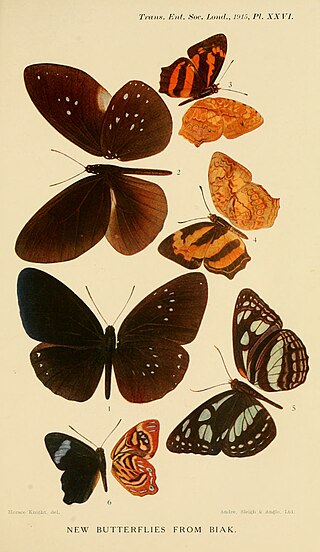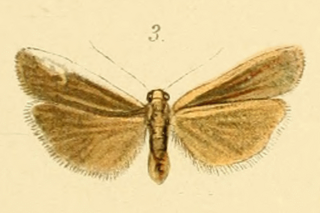
Lottia is a genus of sea snails, specifically true limpets, marine gastropod mollusks in the subfamily Lottiinae of the family Lottiidae, one of the families of true limpets.

Anthomyzidae is small, slender, yellow to black flies with narrow and elongated wings, which may have distinct markings. Some species have greatly reduced wings. Fewer than 100 species are known, mostly from Europe. Although they occur in all major regions, they seem to be most varied in the Holarctic region.

The Biak dark crow is a species of nymphalid butterfly in the Danainae subfamily. It is endemic to Indonesia.
Coreura is a genus of moths in the subfamily Arctiinae. The genus was erected by Francis Walker in 1865.

Diduga is a genus of moths in the family Erebidae.

Acartophthalmus is a genus of flies, and the only genus with confident placement in the family Acartophthalmidae. They are 1.0–2.5 millimetres (0.04–0.10 in) long, and grey or black in colour, with pubescent arista. Only five species are included.
Meteura is a genus of moths in the subfamily Arctiinae erected by George Hampson in 1900.

Agrotis ripae, the sand dart, is a moth of the family Noctuidae. The species was first described by Jacob Hübner in 1823. It is found in western Europe and North Africa and extends east across the Palearctic to steppe areas in Russia, Mongolia and Siberia.
Ancylosis albicosta is a species of snout moth in the genus Ancylosis. It was described by Otto Staudinger, in 1870. It is found in Romania, Russia, Turkey, Lebanon and Algeria.
Carthara is a genus of snout moths. It was described by Francis Walker in 1865 and is known from Colombia.
Carthara albicosta is a species of snout moth in the genus Carthara. It was described by Francis Walker in 1865. It is found from the Amazon basin to Costa Rica.

Epipsestis is a genus of moths belonging to the subfamily Thyatirinae of the Drepanidae. It was erected by Shōnen Matsumura in 1921.
Oboronia albicosta is a butterfly in the family Lycaenidae. It is found in Cameroon, the Democratic Republic of the Congo, Uganda and Zambia. In Seitz it is described - Forewing only at the base feebly dusted with dark, at the distal margin somewhat broader black than pseudopunctatus, more like punctatus. On the hindwing the marginal band is as broad as in punctatus, but the white rings in it are only indistinctly pronounced. Beneath on both wings the black eyespots with white rings are more distinct than in punctatus. On the hindwing all the marginal spots are black, not only that in area 2, which shows blue scales, like in punctatus. The costal margin of the hindwing lacks the spot,and there are only traces noticeable of submarginal yellow lines at the proximal margin and between R 4 and R. 6. Expanse of wings: 30 mm.

Eilema albicosta is a moth of the subfamily Arctiinae first described by Alois Friedrich Rogenhofer in 1894. It is found in Spain and on the Canary Islands.
Striacosta is a genus of insect, belonging to the family Noctuidae. It contains only one species, Striacosta albicosta, which is found in North America.
Orthopodomyia is a genus of mosquitoes in the family Culicidae. There are at least 40 described species in Orthopodomyia.
Ischnomyia spinosa is a species of fly in the family Anthomyzidae.
Ischnomyia is a genus of flies in the family Anthomyzidae. There are at least two described species in Ischnomyia.

Sphacophilus is a genus of sawflies in the family Argidae. There are more than 30 described species in Sphacophilus.
Pseudacidalia albicosta is a moth of the family Noctuidae first described by Frederic Moore in 1885. It is found in Sri Lanka.








